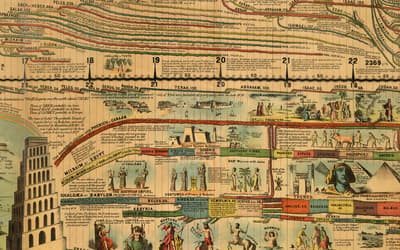The views expressed in this paper are those of the writer(s) and are not necessarily those of the ARJ Editor or Answers in Genesis.
Abstract
As previously explained in this journal, it is not possible to run the Egyptian Old and Middle Kingdoms in parallel. Also, the date of the Trojan War is not necessarily that provided by ancient Greek historians.
Keywords: Egyptian history, Old Kingdom, Middle Kingdom, Middle East, Bronze Age, Trojan War
The Old and Middle Kingdom Sequence
The third paper by Griffith and White in their series in this journal (Griffith and White 2023), while not without some interesting points, has a fundamental error. I recently pointed this out in the debate (Porter 2022b) following my paper “The Place of the Exodus in Egyptian History” (Porter 2022a). Griffith and White (2023) want to overlap the Egyptian Old and Middle Kingdoms (Griffith and White 2023, 152, point 3 and fig. 10). Their fig. 10 shows Nitocris of Dynasty 6 (Old Kingdom) after(!) Sesostris III of Dynasty 12 (Middle Kingdom), but the two kingdoms are archaeologically in a sequence and separated from each other by the First Intermediate Period, as explained in my responses to the earlier debate (Porter 2022b). However, I think Griffith and White and myself are in agreement that the Exodus should be placed close to the end of Dynasty 6, about the time of Nitocris who probably replaced the pharaoh who died in the Red Sea.
Some Christian chronologists try to ignore historical and archaeological sequences. I will briefly outline two sequences that apply in the ancient Middle East:
- In Egypt there was a historical sequence of Old Kingdom, Middle Kingdom, and New Kingdom, each followed by Intermediate Periods when central authority broke down. It is especially in the Intermediate Periods that there is scope for shortening chronology (Porter 2022a). I showed in Porter (2022b) that the Old Kingdom was before the Middle Kingdom. The New Kingdom followed the other two because various New Kingdom inscriptions list their predecessors from the Old and Middle Kingdoms, notably Seti I’s Abydos king list (for example, see pharaoh.se/abydos-canon).
- In the Middle East generally, there is an archaeological sequence of Early Bronze, Middle Bronze, Late Bronze, and Iron Age, each with sub-divisions. Although named after metals, this sequence is based on changing styles of various types of artefacts, especially pottery. The sequence, or parts of it, has been excavated at numerous sites, particularly in the Levant (Israel, Jordan, Lebanon, and western Syria) but also in Greece, Turkey, and elsewhere. Many of the sites in Israel/Palestine are outlined in Stern (1993), for example, vol. 3, 1003–1024, “Megiddo,” which has a table of the strata and photos and plans of some of the Megiddo strata.
Roughly speaking, these two sequences correspond as in table 1. Tying the two sequences together, there are inscribed artefacts from the Egyptian kingdoms that have been found in stratified archaeological deposits in the Levant, and trade items from the Levant (for example, storage jars) that have been found in stratified archaeological deposits in Egypt, thus confirming table 1. These are real sequences which cannot be reversed or greatly overlapped because they have been excavated stratigraphically in various locations (that is, oldest remains at the bottom, latest at the top). Therefore, part of Griffith and White’s Egyptian chronology is a non-starter! The way forward is, as I outlined in Porter (2022a), to accept the sequences and shorten them.
Table 1. Approximate correspondences between Levant archaeological sequence and Egyptian periods.
| Early Bronze Age | Old Kingdom |
| Middle Bronze Age | Middle Kingdom |
| Late Bronze Age | New Kingdom |
The Trojan War
Another error of Griffith and White (2023) concerns their use of ancient writers, particularly Greek writers. Greek historians were not Bible-believers and were no better than modern scholars at dating events long before their own time. Griffith and White follow Eratosthenes and date the end of the Trojan War to 1184 B.C. (Griffith and White 2023, 133–135, their “Anchor Point-12”). Homer’s story of the attack on Troy by a Mycenean Greek fleet fits nicely with the fiery destruction of Stratum VIIa (or possibly a neighbouring stratum). Most modern historians also date the fall of Troy in the region of 1184 B.C., placing it near the end of the Late Bronze Age, and they thereby create the Greek “Dark Age,” a false period of several centuries during which little happened in Greece historically or archaeologically, just a long drawn out pottery sequence. Griffith and White (2023) correctly want to remove this dark age by moving the end of the Late Bronze Age but that also moves Stratum VII later. They are therefore forced to separate the Trojan War from its natural archaeological setting in Troy’s Stratum VII and wrongly claim that the war occurred in a much earlier archaeological period, in Minoan times (the Minoan civilisation came before that of the Myceneans). Griffith and White (2023) have been further misled by some modern authors and suggest that Troy was really at Pergamon, far to the south and 20 km from the sea!
References
Griffith, Ken, and Darrell K. White. 2023. “Chronological Framework of Ancient History. 3: Anchor Points of Ancient History”. Answers Research Journal 16 (March 22): 131–154. https://answersresearchjournal.org/ancient-egypt/chronological-framework-ancient-history-3/.
Porter, Robert M. 2022a. “The Place of the Exodus in Egyptian History”. Answers Research Journal 15 (February 16): 1–9. https://answersresearchjournal.org/ancient-egypt/place-of-exodus-egyptian-history/.
Porter, Robert M. 2022b. “The Place of the Exodus in Egyptian History: Reply #1”. Answers Research Journal 15 (May 25): 125–127. https://answersresearchjournal.org/ancient-egypt/place-of-exodus-egyptian-history-reply-porter/.
Stern, Ephraim, ed. 1993. The New Encyclopedia of Archaeological Excavations in the Holy Land. 4 vols. Jerusalem, Israel: Carta.





